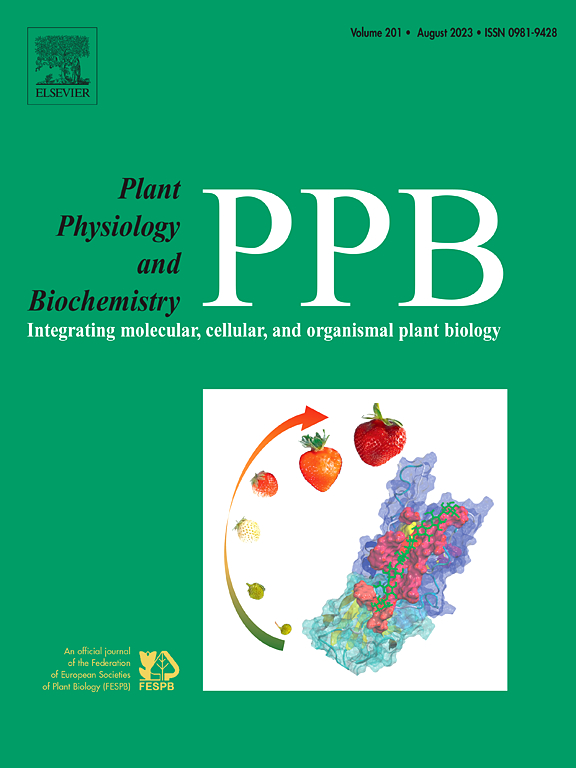Effects of monochromatic light on growth and development of Phoebe bournei seedlings tend to be "extreme"
IF 6.1
2区 生物学
Q1 PLANT SCIENCES
引用次数: 0
Abstract
Light quality is a key factor affecting seedling regeneration in natural Phoebe bournei forests. We used the current-year P. bournei seedlings as experimental materials and cultured them under five LED spectral conditions for 60 days to explore the response mechanism of P. bournei seedlings to different light qualities (blue, red, green, blue-red (1:1) and white (control)). We analyzed the impact of monochromatic lights and blue-red mixed light on leaf structure, starch, soluble sugar, soluble protein, root development, and seedling quality of P. bournei seedlings. The effects of monochromatic light on the development of P. bournei seedlings tended to be "extreme". Red and green light increased starch grain size by 2.12 and 2.03 times compared to white light. The excessive accumulation of starch grains disrupted the ultrastructure of chloroplasts, inhibited the synthesis and utilization of carbohydrates, and thus limited the development of seedlings. Blue light accelerated the transport and utilization of carbohydrates, significantly improved the development of chloroplast ultrastructure, and activated the rapid growth of seedlings. Especially, blue light promoted the formation of lateral roots, and significantly increased leaf area, leaf thickness, and stomatal density. However, the allocation of stem biomass was reduced under blue light, resulting in imbalanced inter-organ development and decreased seedling resistance. In contrast, under the blue-red light, the chloroplast development state, the relationship between storage and utilization of starch and other substances, as well as carbon and nitrogen metabolic activities in seedlings were more coordinated, indicating that multispectral light has the potential to cultivate P. bournei seedlings of superior quality. Although the seedling quality index (SQI) of P. bournei under the blue-red light in this experiment did not reach its best, our findings provide a valuable theoretical basis of high-quality P. bournei seedlings and for regulating the light environment when planting P. bournei under the forest canopy.
单色光对菲比幼苗生长发育的影响趋于“极端”。
光质量是影响天然菲比林幼苗更新的关键因素。本研究以当年柏树幼苗为实验材料,在5种LED光谱条件下培养60 d,探讨柏树幼苗对不同光质(蓝、红、绿、蓝红(1:1)、白光(对照))的响应机制。本研究分析了单色光和蓝红混光对白杨幼苗叶片结构、淀粉、可溶性糖、可溶性蛋白、根系发育和幼苗品质的影响。单色光对柏树幼苗发育的影响趋于“极端”。与白光相比,红光和绿光使淀粉颗粒大小分别增加了2.12倍和2.03倍。淀粉粒的过量积累破坏了叶绿体的超微结构,抑制了碳水化合物的合成和利用,从而限制了幼苗的发育。蓝光加速了碳水化合物的运输和利用,显著改善了叶绿体超微结构的发育,激活了幼苗的快速生长。特别是蓝光促进侧根的形成,显著增加叶片面积、叶片厚度和气孔密度。但在蓝光照射下,茎生物量分配减少,导致器官间发育不平衡,幼苗抗性降低。相比之下,在蓝红光下,叶绿体发育状态、淀粉等物质的储存与利用关系以及幼苗体内碳氮代谢活动更加协调,说明多光谱光有可能培育出优质的柏木幼苗。虽然本实验蓝红光下的柏树幼苗质量指数(SQI)没有达到最佳,但我们的研究结果为优质柏树幼苗的培育和林冠下柏树种植的光环境调控提供了有价值的理论依据。
本文章由计算机程序翻译,如有差异,请以英文原文为准。
求助全文
约1分钟内获得全文
求助全文
来源期刊
CiteScore
11.10
自引率
3.10%
发文量
410
审稿时长
33 days
期刊介绍:
Plant Physiology and Biochemistry publishes original theoretical, experimental and technical contributions in the various fields of plant physiology (biochemistry, physiology, structure, genetics, plant-microbe interactions, etc.) at diverse levels of integration (molecular, subcellular, cellular, organ, whole plant, environmental). Opinions expressed in the journal are the sole responsibility of the authors and publication does not imply the editors'' agreement.
Manuscripts describing molecular-genetic and/or gene expression data that are not integrated with biochemical analysis and/or actual measurements of plant physiological processes are not suitable for PPB. Also "Omics" studies (transcriptomics, proteomics, metabolomics, etc.) reporting descriptive analysis without an element of functional validation assays, will not be considered. Similarly, applied agronomic or phytochemical studies that generate no new, fundamental insights in plant physiological and/or biochemical processes are not suitable for publication in PPB.
Plant Physiology and Biochemistry publishes several types of articles: Reviews, Papers and Short Papers. Articles for Reviews are either invited by the editor or proposed by the authors for the editor''s prior agreement. Reviews should not exceed 40 typewritten pages and Short Papers no more than approximately 8 typewritten pages. The fundamental character of Plant Physiology and Biochemistry remains that of a journal for original results.

 求助内容:
求助内容: 应助结果提醒方式:
应助结果提醒方式:


